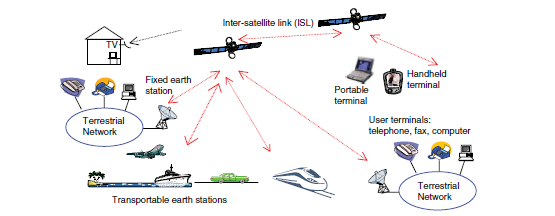Above ref:- Satellite Communication system by GERAND MARAL|MICHEL BOUSQUET|ZHILI SUN
There are basic 5 building blocks for satellite internet shown in image.
Satellite internet is wireless internet beamed down from satellites orbiting the Earth. It’s a lot different from land-based internet services like cable or DSL, which transmit data through wires. Since it’s the only internet service that’s available nationwide, satellite internet is often the only way to get online for many rural homes and businesses, although it does still come with a few disadvantages like live gaming or services which require less latency .
Satellite comminication main moto to make signal available at each and every point of earth.
There are 3 types of satellite
I am assuming that how a satellite can cover earth area depending upon its height from earth , means higher the atltitude possibility of covering earth from lesser no of satellites and lower the altitude higer no of satellite required to cover earth .
. The altitude of LEO satellite: 500km-2000km
· The altitude of MEO satellite: 2000km-36000km
· The altitude of GEO satellite: 36000km
For LEO or medium earth orbit (MEO) satellites, a large number of satellites are needed
to provide continuous global coverages. In cases of LEO, the Iridium Next (constellation of
second-generation Iridium satellites) has 66 satellites plus 6 spares; OneWeb plans to have 648
satellites plus 252 spares; and Starlink by SpaceX plans to have 4425 satellites plus some spares.
In case of MEO, O3b has 20 satellites including 3 on-orbit spares, all operating in equatorial
orbit
Below is table related to frequency of satellite service operation
Above ref:- Satellite Communication system by GERAND MARAL|MICHEL BOUSQUET|ZHILI SUNSatellite Coverage and its coverage area
Relationship between coverage and frequency bands
Beam defines a beam coverage area, also called a footprint, on the earth surface. The aggregate beam
coverage areas define the multibeam antenna coverage area. A given satellite may have several
Single-beam satellite- where each transmit and receive antenna generates one beam only.One could also consider multiple-beam antennas.
Links between Satellite called ISL
Intersatellite links make the following configurations possible:
— The use of a geostationary satellite as a relay for permanent links between low orbit satellites
and a network of a small number of earth stations.
— An increase in system capacity by combining the capacities of several geostationary satellites.
— The planning of systems with a higher degree of flexibility.
— Consideration of systems providing a permanent link and worldwide coverage using low orbit satellites as an alternative to systems using geostationary satellites.
Lets talk about Frequencies ,Beams, Carrier , Channels etc
Above ref:- Satellite Communication system by GERAND MARAL|MICHEL BOUSQUET|ZHILI SUNSatellite on-board connectivity defines how the satellite network resources are switched on
board in order to meet the service-level connectivity requirements. It therefore depends on how
the satellite resources (beams, channels, carriers, etc.) are organised on both satellite up- and
downlinks and, primarily, on the type of coverage that the satellite system provides. In the
case of global coverage, any user within the coverage can, in principle, be connected to any other user. In multibeam coverage, interconnection of any user within different beams of the
coverage requires on-board interconnection of beams and of the resources allocated to those
beams.
Spot-beam: The whole frequency resource allocated to a beam is switched on board. This can
correspond to a channel or several channels (typically 125 or 250MHz in Ka band).
Channel: This is equivalent to the frequency resource that is classically transmitted through a
transponder (typically 36 or 72 MHz).
Carrier: This can be an FDMA carrier transmitted by a satellite terminal or earth station, or a
multi-frequency time division multiple access (MF-TDMA) carrier shared by several satellite
terminals (typically from a few kHz up to tens of MHz depending on the earth station radio
capability).
Time slot: This corresponds to time division multiplex (TDM) or TDMA time slots.
Burst, packet, or cell: This corresponds to any type of layer 2 packet, up to IP datagrams.Aburst
is a group of packets or cells travelling together on the same link; a packet has a variable size
and contains a block of data; and a cell has a fixed size
An MF-TDMA channel is defined as a certain bandwidth divided into a number of sub-bands.
Each sub-band may consist of a particular carrier type or a combination of several carrier types.
Three types of carrier are considered:
Logon carrier: A CSC burst and a number of TRF bursts or CSC bursts and SYNC bursts
Synchronisation carrier: SYNC bursts and TRF bursts or SYNC bursts alone
Traffic carrier: TRF bursts
The frame duration is partitioned into time slots according to carrier type (CSC, SYNC, or TRF),
carrier rate (C1, C2, C3, and C4), and carrier configuration (number of MPEG-2 packets per
burst).
A typical configuration of the MF-TDMA uses a bandwidth of 36MHz that is divided into
four sub-bands of 9 MHz; the sub-bands are configured with 16C1 carriers, 8C2 carriers, 4C3
carriers, or 2C4 carriers. Each of the sub-bands may be configured independently. At least one
sub-band is configured with C1 carriers for logon and synchronisation needs
Above ref:- Satellite Communication system by GERAND MARAL|MICHEL BOUSQUET|ZHILI SUN
Future/Present of Satellite Communication
Below table shows how satellite communication and participating organisations are reacting towards future communication .
w.r.t. some cons there are more pros of satellite communication with biggest advantage of availability of coverage with similar capacity of LTE
Above ref:- Satellite Communication system by GERAND MARAL|MICHEL BOUSQUET|ZHILI SUN
Below are some details taken from Indian market prospect and i am able to see very huge opportunity of satellite based services as latency not looking to be more chalaning when we compare with 4G /LTE
Above ref:- ookla /Open signal











Good one
ReplyDeleteThanks
DeleteVery informative captured all aspects...great going Ramanuj
ReplyDelete